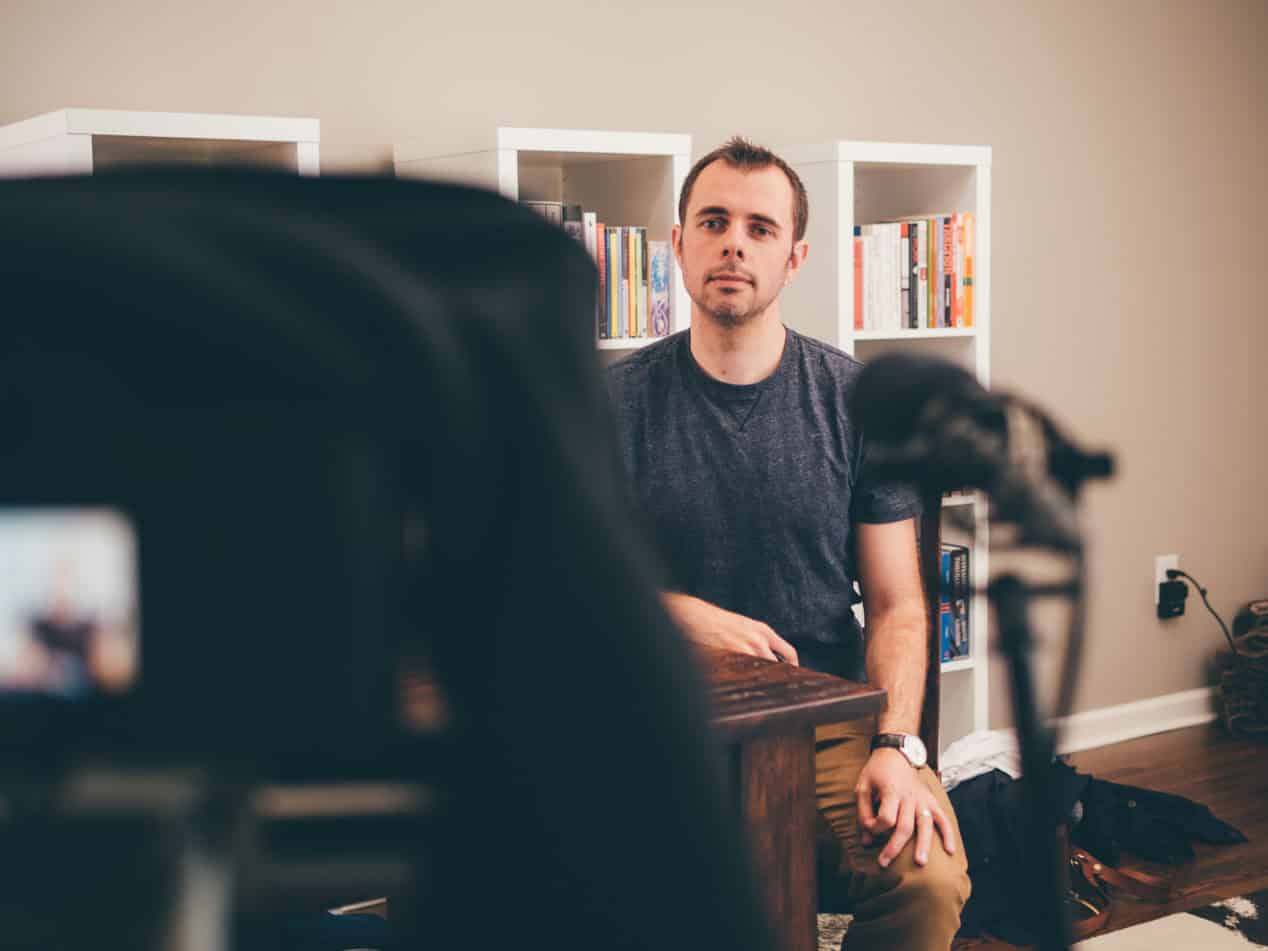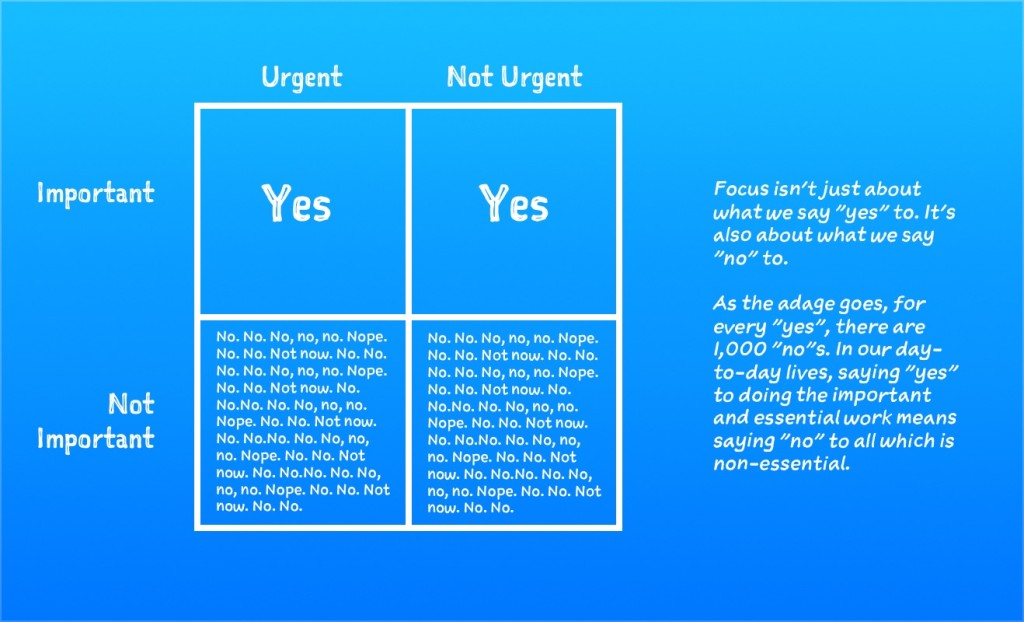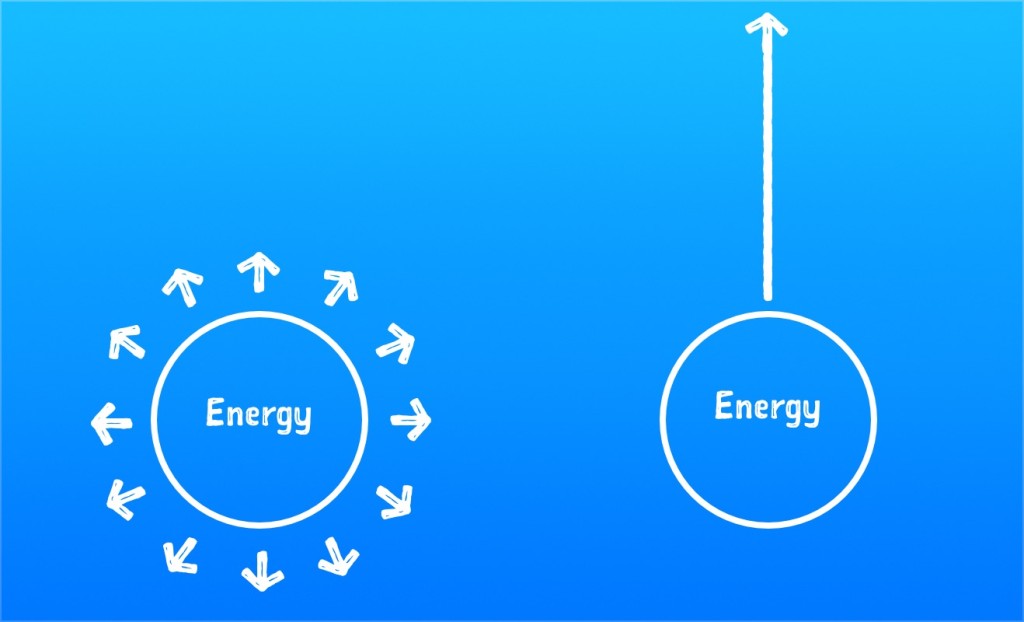How do you keep focused doing the things that matter even when they’re a grind?
Reader Alan N. just recently asked me this question and it’s an excellent one.
Most of the time, the things that matter are a grind. Why is that? It seems unfair that the most important work is often mundane and difficult. Not to mention that usually the most important work is not even due today.
But that’s the truth of it. We have to define the things that matter and then seek them out and act on them. If we want to do the things that matter, we have to show up every day and do them.
The topic of meaningful productivity is central to The Focus Course.
In short, at the end of the day, meaningful productivity is about consistently doing the things that matter. Contrary to popular belief, real productivity has very little to do with how many emails we can reply to and then archive in less than 60 seconds.
That said, the way we keep focused on the things that matter even when they’re a grind, is two-fold: (1) Make doing the most important work part of your routine; and (2) celebrate your daily progress.
On the other side of that coin is overcoming two of the greatest areas of resistance to doing meaningful work every day: Inbox Addiction and Urgency Addiction.
Make Doing the Most Important Work Part of Your Routine
I write for a living. And I’ve found that having a common time, common place, and even the same theme music for my writing has made a profound impact on my ability to show up every day and write.
When you look at it from the outside, it sounds silly or boring. But in practice it’s a bit cathartic, and it’s the time of my day I most look forward to. When I know when and where I’ll be writing, and what I’ll be writing about, I can’t wait to get to work.
It wasn’t until just three months ago that I actually set a routine in place for when and where I would write:
- Every morning I write for at least 30 minutes no matter what. That’s my commitment: 30 minutes. This writing time is the first thing I do each morning when I start my work day. And though I’m committed to write for at least just 30 minutes, I usually end up writing for about 2.5 hours. Once I’ve pressed through that initial half-hour, I find a flow and just keep going.
-
I play the same music every morning during my 30 minutes of writing time. It’s the Monument Valley soundtrack. On repeat. I put on my headphones and hit play on that album. I probably listen to it 3 or 4 times every day. The advantage is that it just becomes like white noise — because it’s familiar it’s not distracting. And because I’m always listening to this music when I’m writing, the music itself now has a Pavlovian effect that helps me focus in on “writing mode”.
-
Additionally, I do not check any statistics or inboxes until at least 9:00 am. Since I start my work day at 7:30am, I have a minimum of 90 minutes where my only goal is to write, think, or plan.
Thus, not only do I have a commitment to do the work, but also a commitment to not give in to any potential distractions while I’m doing the work. As I’m sure you know, it’s one thing to show up and another thing altogether to actually create something in the time you’ve given yourself.
Since I began this morning writing routine three months ago, I’ve written somewhere in the ballpark of 90,000 words. This includes my Fight Spot newsletters, podcast scripts and talking points, 31 days (so far) of my 40-day Focus Course, and the first draft of a top-secret new ebook we will be publishing through The Sweet Setup in a few months.
Having this routine in place does more than just create the space for me to do my most important work. It also reserves my willpower and creative energy for that which matters most: doing the actual work.
When I start writing in the morning, I already know what I’m going to write about (because I choose each day’s writing assignment the day before). I also already know how long I’m going to write for (at least 30 minutes), and that I’m not going to do anything else.
There is literally nothing for me to think about other than moving the that big blue blinking cursor from left to right.
It’s most difficult at the beginning
The hardest part of turning our most important work into part of our routine is at the beginning. As we implement a new daily habit, the most energy required is at the outset.
They say it takes 21 days to form a new habit. But that’s the minimum. For most people it is more like 66 days — about two months. But, once you’ve done something for two months then the discipline required to keep doing it is greatly reduced.
So, for example, writing 1,000 words every day can be extremely challenging for the first week. Then a bit less challenging the week after. Until, after about 8 weeks, you’re practically on autopilot. If you can muster the discipline and diligence to stick with it for a couple of months, then pretty soon the routine of it takes over.
Choose to do something every day until eventually it chooses you back.
Celebrate Your Progress
At the end of every day, I open up my Day One journal and write down the highlights of what I accomplished that day. It usually includes the topic I wrote about and how many words I put down, any meaningful connections or conversations I had, and any other miscellaneous thoughts.
By recognizing and rewarding these small wins each day, it builds up an intrinsic motivation that makes me want to keep doing the important work.
Celebrating progress strengthens our emotional and motivated state. Which means we are happier and more motivated at work and are therefore more likely to be productive and creative. It keeps the cycle going.
We may know what our most important work is. And we may know that we should be spending time on it every day. But oftentimes that head knowledge is not heart knowledge. We don’t feel the value in what we’re doing.
When we feel like cogs in a machine (even cogs who know they’re doing something they think is important) then we slowly lose our desire to be productive and efficient. We don’t care about coming up with creative solutions or fresh ideas. We just do what’s required of us in order to get our paycheck so we can go home to our television and unwind.
By cataloging and celebrating our small wins each day then we can be reminded that we are making meaningful progress. And, in truth, it’s the small wins which all add up to actually complete the big projects and big goals.
Note: I was recently interviewed for an episode of the Fizzle show where Chase Reeves discussed how to use a productivity journal. It’s an excellent podcast episode — tightly edited and constructed, like an episode 99pi or something you’d hear on NPR.
Inbox Addiction (“The Just Checks”)
Here’s how I define Inbox Addiction:
Inbox Addiction is an urge to continuously check one’s news feeds, social feeds, and message inboxes despite undesirable and even negative consequences or a desire to stop.

Street art from London’s famous graffiti artist, Banksy.Inbox addiction poses a serious threat to doing our best creative work and staying on focus with our essential tasks. The addiction of checking and refreshing our inboxes, timelines, and stats robs us of our ability to focus as well as our ability to do substantial, meaningful work. It’s a drain on our time as well as a drain on our creative energy.
Last fall I wrote about some alternatives to The Just Checks. In short, when I’m in line at the store or have a moment of down time, instead of habitually checking Twitter or email or Instagram, I try to instead scroll through my Day One timeline (the Day One Today extension for iOS 8 that shows two random photos is great for this, btw) or send an encouraging text message to a friend.
Urgency Addiction
Urgency Addiction in a Nutshell
Stephen Covey defines Urgency Addiction as this:
Urgency addiction is a self-destructive behavior that temporarily fills the void created by unmet needs. And instead of meeting these needs, the tools and approaches of time management often feed the addiction. They keep us focused on daily prioritization of the urgent. […]
It’s important to realize that urgency itself is not the problem. The problem is that when urgency is the dominant factor in our lives, importance isn’t.
The reason urgency addiction robs us of doing our most important work is because essential work is often mundane.
One reason we love to give our energy and attention to doing what is urgent is because it feels exciting. There is a natural momentum and adrenaline that accompanies things which are urgent.
Contrast that against doing what is essential.
Back to the writing example: suppose you are writing a book. The essential work is that you must put words down. And yet, that is so often the very task we neglect and avoid. Because it’s difficult, boring, tedious, mundane. We instead let our days get filled with many other more pressing (“urgent”) matters, and never get to the foundational and important work of writing.
When something is essential, it is absolutely necessary. Essential is the very definition of what’s truly important
Urgent is relative, but essential is absolute. While urgency is usually defined by external factors, essentialness is fundamentally important to a project or goal, regardless of external factors.
Urgency in and of itself is not a problem. The problem is when we find ourselves craving projects, work environments, and scenarios where there is a fire to put out. And thus we never have the time to do the important task which doesn’t have to be done today.
Urgency addiction is when we allow our time to be taken over by whatever is most urgent in the moment. When that happens, we give no consideration to what’s down the road and no priority to the long-term goals. Moreover, it leaves no space for us to walk out our daily habits and lifestyle practices — they get set aside, sacrificed for the sake of yet another urgent crisis or pressing matter.
How often do you feel frustrated at the end of the day because your most important tasks are still not done? How often do you blame the rush and press of external things for your failure to do the work you know to be most important? How often do you find yourself giving up quality time with important people so that you can finish a project or respond to a crisis?
To let our lives be taken over by what is only urgent is to live like a child — caring only about what seems important right now with no regard for the future and without even knowing what is actually important today.
So long as our attention is focused on the urgent and the incoming, we won’t be able to do our best work. We won’t make any meaningful progress toward our goals because we will be dealing only with the tasks and situations which are urgent while we neglect the ones which are essential.
* * *
The newness of a project brings an energy that motivates us to get started. And the urgency of a deadline brings an energy that motivates us to finish. But what about in-between? How do we keep on doing the work in-between starting something new and finishing it? Because the vast majority of our life is lived in that “in-between state”.
Joy in the Journey
The best musicians in the world practice every single day. For hours a day. And they don’t just practice their favorite songs and coolest licks — they practice the techniques and scales and fills that they’re bad at.
I studied martial arts for over a decade, and we did the same stretches and basic moves at the start of every class every time. Even after I received my black belt, we were still practicing basic front stance and middle punch.
You write a book by writing it. Thinking about it, outlining it, researching for it, yeah you’ve got to do these. But you’ve also got to sit down and write it. Even if you can write 1,000 words every day, you’re looking at a couple of months to write the first draft.
Something the best musicians, the martial artists, and writers all have in common is more than just commitment and fortitude. More than just routine. They have a joy in the journey.
And while the musician, martial artist, and writer all have goals they’re working toward, the goal is not the primary motivation. When we delight in the journey, then the daily grind becomes what we get to do. Not something we have to do.
In his book, Mastery, George Leonard writes that “love of your work, willingness to stay with it even in the absence of extrinsic reward, is good food and drink.”
When we’re doing work that matters there is no finally moment. The tension and the difficulty never go away. The distractions and excuses will always be around. Hard work will always be hard work. The goal is not to eliminate the tension but to thrive in the midst of it.
P.S. I’ve built a guided, online course about doing our best creative work and living a focused life. If you’d liked this article, I bet you’ll love the course.












